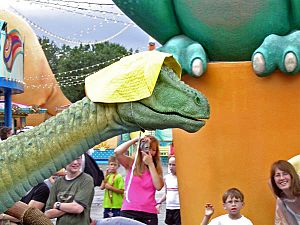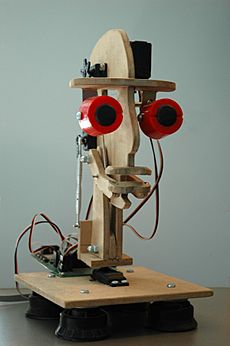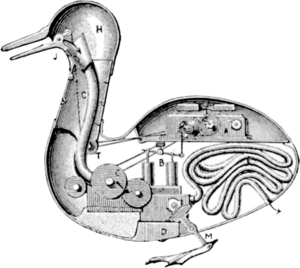Animatronics facts for kids

Animatronics are special puppets or figures that move automatically. They use electronics and robotics to make them seem alive. You often see animatronics in movies, theme parks, and other fun places. They help bring characters to life, making stories and attractions more exciting.
Contents
How Animatronics Are Made
Animatronics are built with many parts, just like a real creature. They have a strong inner frame, like a skeleton. This frame holds all the electronics and moving parts.
The "skin" of an animatronic is usually made from soft materials. These include foam rubber, silicone, or urethane. These materials are poured into molds to get the right shape. Sometimes, fabric is added inside the skin for extra strength. Once the skin parts are ready, they are attached to the frame. This gives the animatronic its realistic look and feel.
The Inner Structure
Animatronics are designed to look as real as possible. Their inside structure is much like a living thing.
The "Skeleton" or Frame
The main support for an animatronic is its frame. This frame is like a skeleton. It can be made from steel, aluminum, plastic, or wood. The best material depends on how strong it needs to be and how much it will weigh.
The "Skin" or Exterior
Many different materials are used for the outside of an animatronic. The goal is always to make it look as lifelike as possible. For example, the "eyes" and "teeth" are often made from a clear plastic called acrylic.
Latex Skin
White latex is a common material. It is very stretchy and easy to use. A special type called foam latex is light and soft. It is used for realistic "skin" on animatronics. It was even used in the classic movie The Wizard of Oz in the 1930s.
Silicone Skin
Disney has a special team that works on making animatronic skin even better. They often use silicone. Silicone is great for making molds because other materials do not stick to it easily. This makes it simple to create detailed parts.
Polyurethane Skin
Polyurethane rubber is another material used for animatronic skin. It comes in different levels of hardness. Flexible polyurethane foam is often used because it is soft and sticks well to latex.
Plaster Molds
Plaster is a common material. It can be used for making molds, but it is very stiff. This can make it harder to use than softer materials like latex or silicone.
How Animatronics Move
Animatronics move using different systems. Small animatronics might use air pressure, called pneumatics. Larger ones often need more power. They use hydraulics, which use liquid pressure. To make movements look very smooth and natural, animatronics use special systems. These systems allow them to move in many different ways, not just simple back-and-forth motions.
Showing Emotions
Making animatronics show feelings is a big challenge. Humans and animals show emotions with small movements, especially in their faces. Scientists have studied how people show feelings like anger, joy, or surprise. Animatronic designers use this information to make their creations look like they are feeling real emotions. This helps make the characters more believable and fun to watch.
Images for kids
-
West Edmonton Mall's fire-breathing dragon animatronic (1999 - 2014)
See also
 In Spanish: Animatrónica para niños
In Spanish: Animatrónica para niños





